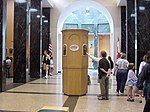Portal:Baseball/Selected list/20
The National Baseball Hall of Fame and Museum is an American museum and hall of fame that is the central point for the study of the history of baseball in the United States and beyond, the display of baseball-related artifacts and exhibits, and the honoring of persons who have excelled in playing, managing, and serving the sport. Elections commenced in 1936 for the selection of worthy individuals to be honored by induction to the Baseball Hall of Fame, though the first induction ceremonies were not held until the Hall opened in 1939. As of July 2009[update], a total of 292 individuals have been selected, including 231 players, 19 managers, 8 umpires, and 31 pioneers and executives. Each is listed along with his primary position; that is, the position or role in which the player made his greatest contribution to baseball, according to the Hall of Fame.
According to the current rules, players must have at least 10 years of major league experience and be retired for at least 5 years to be inducted. Players meeting these qualifications must pass through a screening committee, and are then voted on by the Baseball Writers' Association of America (BBWAA). Each writer may vote for up to 10 players; to be admitted into the Hall of Fame, a player must be approved by 75% of those casting ballots. Players receiving less than 5% approval are removed from future BBWAA ballots. The current rules, most recently revised in July 2007, allow that all players whose careers began in 1943 or later who have not been approved by the BBWAA election process within 20 years of their retirement may be considered by the Veterans Committee in every odd-numbered year, and that umpires, managers, pioneers, and executives may be considered by that committee in even-numbered years. Under the 2007 revised rules, players whose careers began in 1942 or earlier are considered every five years by a special panel selected by the Hall of Fame. Over the years, exceptions have been made to the guidelines in place at the time: Roberto Clemente was elected shortly after his death in 1972; Lou Gehrig was elected in 1939 following his diagnosis with amyotrophic lateral sclerosis; and Addie Joss was elected in 1978 although he completed only nine seasons before his death.
Between 1971 and 1977, nine players from the Negro Leagues were inducted by a special Negro Leagues Committee, which was given the task of identifying worthy players who played in the Negro Leagues prior to the breaking of baseball's color line. Since 1977, players from the Negro Leagues have been considered by the Veterans Committee, and nine more individuals have been approved by that body. In 2005, the Hall announced the formation of a Committee on African-American Baseball, which held a 2006 election for eligible figures from the Negro Leagues and earlier 19th-century teams; Seventeen additional Negro League figures were chosen in that election, including executive Effa Manley, the first woman inducted.

